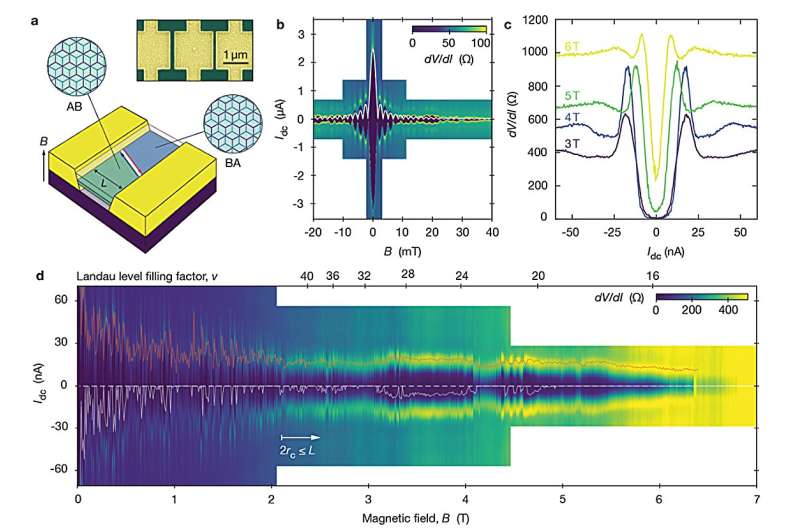The Josephson junction merges domain walls into a minimally twisted double layer.Image source: Julien Barrier et al.
In a major advance in the field of superconductivity, researchers at the University of Manchester have successfully achieved robust superconductivity in high magnetic fields using a newly created one-dimensional (1D) system. The breakthrough provides a promising route to achieving superconductivity in quantum Hall systems, a long-standing challenge in condensed matter physics.
Superconductivity, the ability of certain materials to conduct electricity with zero resistance, holds huge potential for the advancement of quantum technology. However, achieving superconductivity in quantum Hall systems characterized by quantized conductance has proven to be a huge challenge.
The study was published this week (April 25, 2024) in natureIt details the extensive work done by the Manchester team led by Professor Andre Geim, Dr. Julien Barrier and Dr. Na Xin to achieve superconductivity in quantum Hall systems. Their initial efforts followed the traditional route of backpropagating fringe countries close to each other. However, this approach proved to have limitations.
“Our initial experiments were motivated by a strong ongoing interest in the proximity superconductivity induced along quantum Hall edge states,” explains Dr. Barrier, lead author of the paper. “This possibility has led to many theoretical predictions about the emergence of new particles called non-Abelian anyons.”
The team then explored a new strategy inspired by their earlier work demonstrating that the boundaries between domains in graphene could be highly conductive. By placing this domain wall between two superconductors, they achieved the ultimate proximity required between counterpropagating edge states while minimizing disorder effects.
“We were encouraged to observe huge supercurrents at relatively ‘mild’ temperatures up to 1 Kelvin in every device we built,” Dr. Barrier recalled.
Further investigation showed that proximity superconductivity does not originate from quantum Hall edge states propagating along the domain walls, but from strictly one-dimensional electronic states existing within the domain walls themselves.
These one-dimensional states have been proven to exist by Professor Vladimir Fal’ko’s theoretical group at the National Graphene Institute, and they exhibit stronger superconducting hybridization capabilities than quantum Hall edge states. The intrinsic one-dimensional nature of the internal states is thought to be responsible for the robust supercurrents observed at high magnetic fields.
This discovery of single-mode, one-dimensional superconductivity provides exciting avenues for further research. “In our device, electrons propagate in two opposite directions within the same nanometer-scale space without scattering,” explains Dr. Baril. “Such a one-dimensional system is extremely rare and holds the promise of solving a variety of problems in fundamental physics.”
The team has demonstrated the ability to use gate voltage to manipulate these electronic states and observe standing electron waves that modulate superconducting properties.
Dr. Xin concluded: “It is interesting to think about what this novel system can bring us in the future. One-dimensional superconductivity provides another way to realize topological quasiparticles that combine the quantum Hall effect and superconductivity. “This is just one example of the huge potential our discovery has.”
The research by the University of Manchester represents another step forward in the field of superconductivity, 20 years after the introduction of graphene, the first two-dimensional material. The development of this new one-dimensional superconductor is expected to open the door to advances in quantum technology and pave the way for further exploration of new physics, attracting interest from various scientific communities.
More information:
Andre Geim, One-dimensional proximity superconductivity in quantum Hall systems, nature (2024). DOI: 10.1038/s41586-024-07271-w. www.nature.com/articles/s41586-024-07271-w
Provided by the University of Manchester
citation: Scientists develop new one-dimensional superconductor (2024, April 24), Retrieved April 24, 2024, from https://phys.org/news/2024-04-scientists-Dimension-superconductor.html
This document is protected by copyright. No part may be reproduced without written permission except in the interests of fair dealing for private study or research purposes. Content is for reference only.
#Scientists #develop #onedimensional #superconductor
Image Source : phys.org
